EVENT
Dancing Through Hirono: The Sanriku Future Geinoh Festival,The Geinoh Meeting Sep.10th-11th
- 2022
- Experience
- Interact
- Appreciation
-
Date
September 10, 2022 (Sat), 11 (Sun)
-
Time
The Geinoh Meeting (Open Meeting) 16:00~18:00 (open 15:30)
The Sanriku Future Geinoh Festival(Geinoh Performance)13:00~15:30 (open 12:30) -
Locate
Hirono Townspeople Cultural Center (Cecilia Hall)
-
Fee
Free viewing (reservation required, first come, first serve)
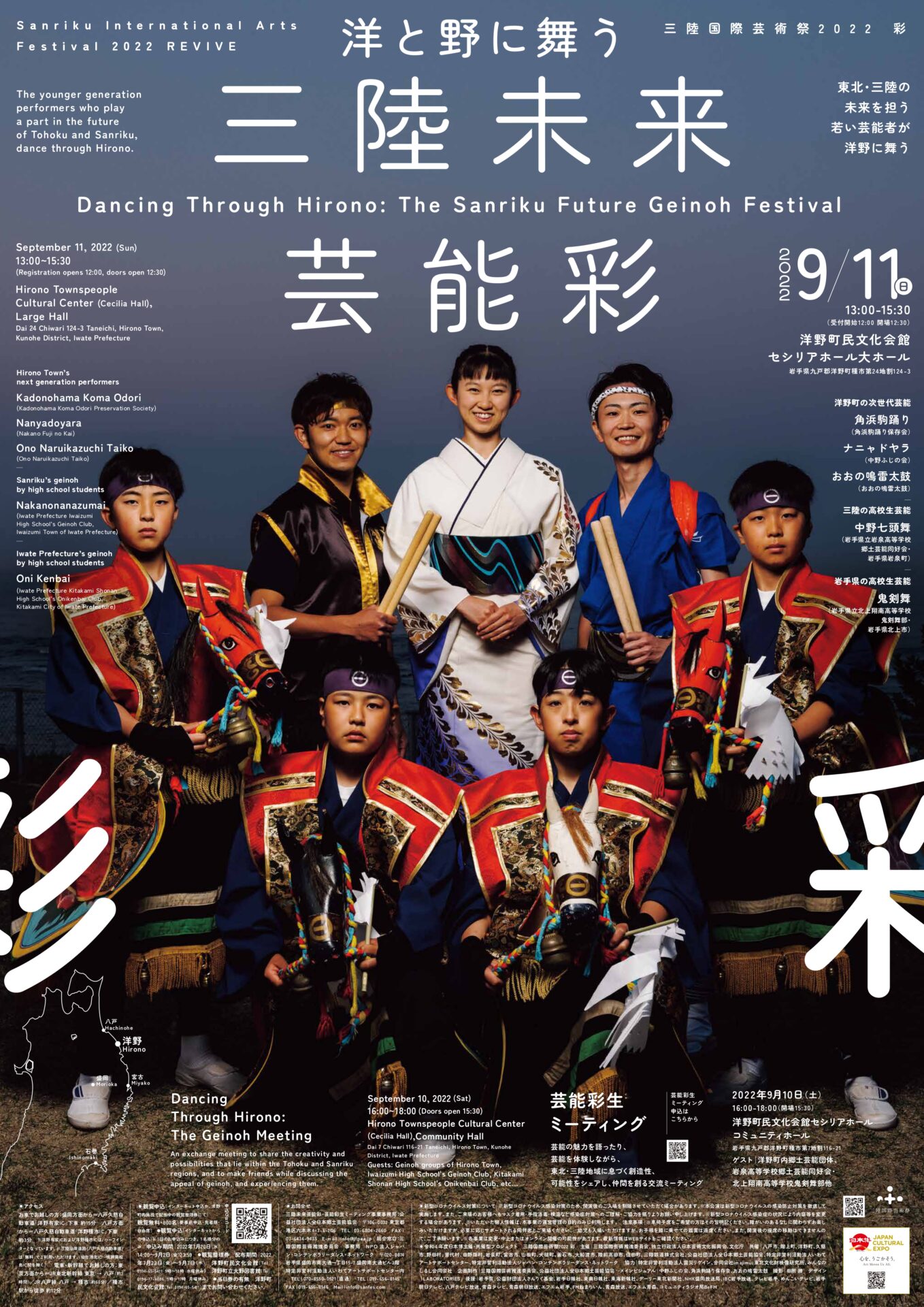
■The Sanriku Future Geinoh Festival■
Geinoh Performance
The next generation performers dancing through Hirono
The Sanriku region is a treasure trove of traditional folk performing arts, incomparable anywhere in the world. Here is an alternative geinoh program focusing on young practitioners of the arts who are the future of the region. The event happens in Hirono Town, rich in nature, surrounded by the ocean (with the kanji, “Hiro”) and the highlands (with the kanji, “no”). Five groups will perform from among the many of the Sanriku coastal area!
The groups from Hirono are: Ono Naruikazuchi Taiko, which will participate in the Sanriku International Arts Festival for the first time; Nakano Fuji no Kai, which is enlivening “Nanyadoyara,” with its wide range of attractive variations; and Kadonohama Koma Odori Preservation Society, who are actively handing down the art form at local elementary and junior high schools.
The Kitakami Shonan High School Onikenbai Club’s Onikenbai and the Iwaizumi High School Geinoh Club’s Nakano Nanazumai will represent Iwate Prefecture at the 46th National High School Arts Festival in Tokyo in August 2022. Don’t miss this rare opportunity to enjoy the diverse geinoh of Hirono, and the top performing arts of Iwate Prefecture’s high school students!
■Appearance■
-
■Hirono Town’s next generation performers
- Hirono Town,Iwate Prefecture| Kadono Hama Koma Odori|Kadono Hama Koma Odori Preservation Society
- Hirono Town,Iwate Prefecture|Nanya Doyara |Nakano Fuji no Kai
- Hirono Town,Iwate Prefecture|Ono Naru Ikazuchi Taiko|Ono Naru Ikazuchi Taiko
- IwaiIwaizumi Town,Iwate Prefecture|Nanazumai|Iwate Prefecture Iwaizumi High School’s Geinoh Club, Iwaizumi Town of Iwate Prefecture
- Kitakami City,Iwate Prefecture| Oni Kenbai|Iwate Prefecture Kitakami Shonan High School’s Onikenbai Club, Kitakami City of Iwate Prefecture
■Sanriku’s geinoh by high school students
■Iwate Prefecture’s geinoh by high school students
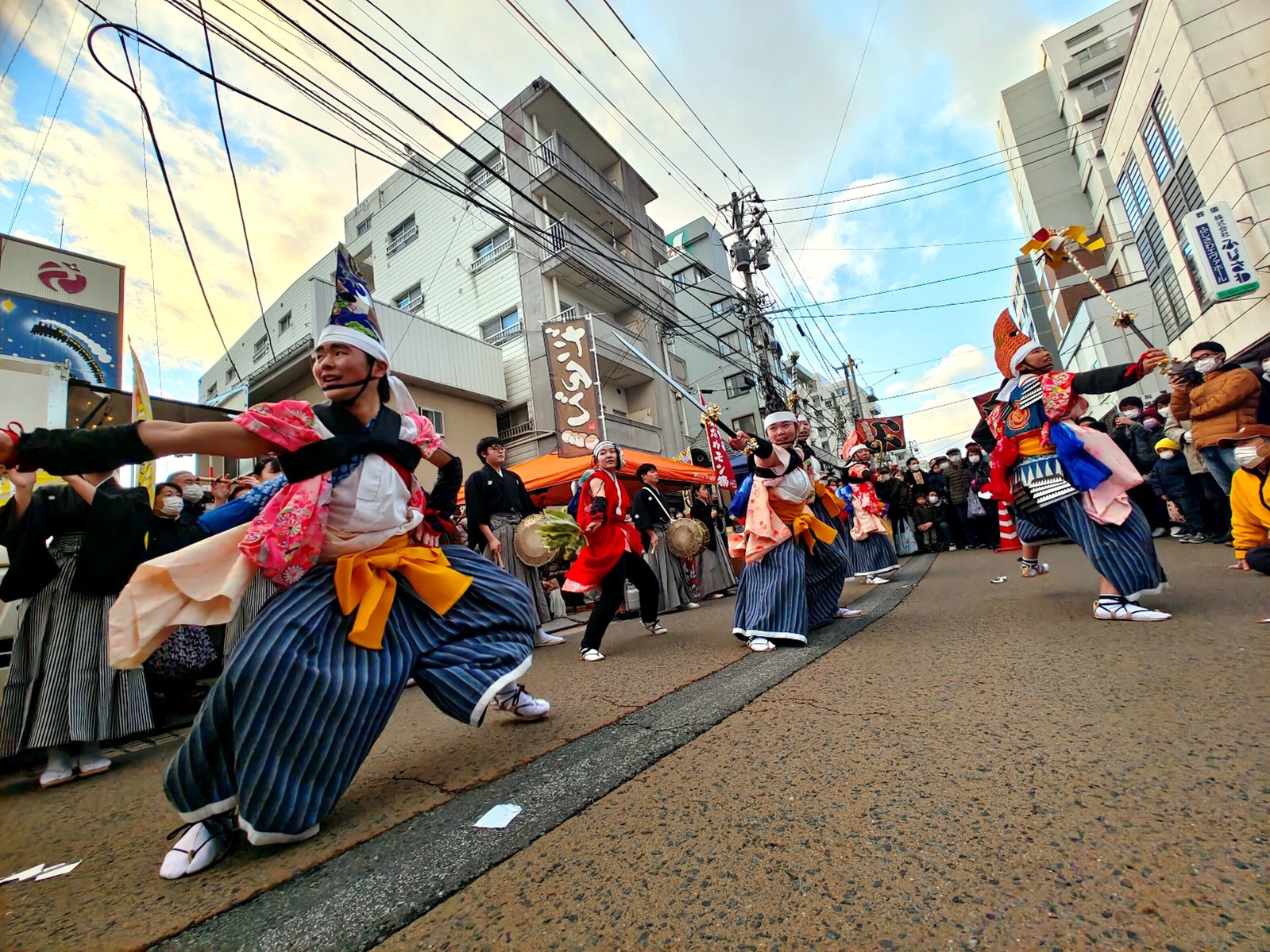
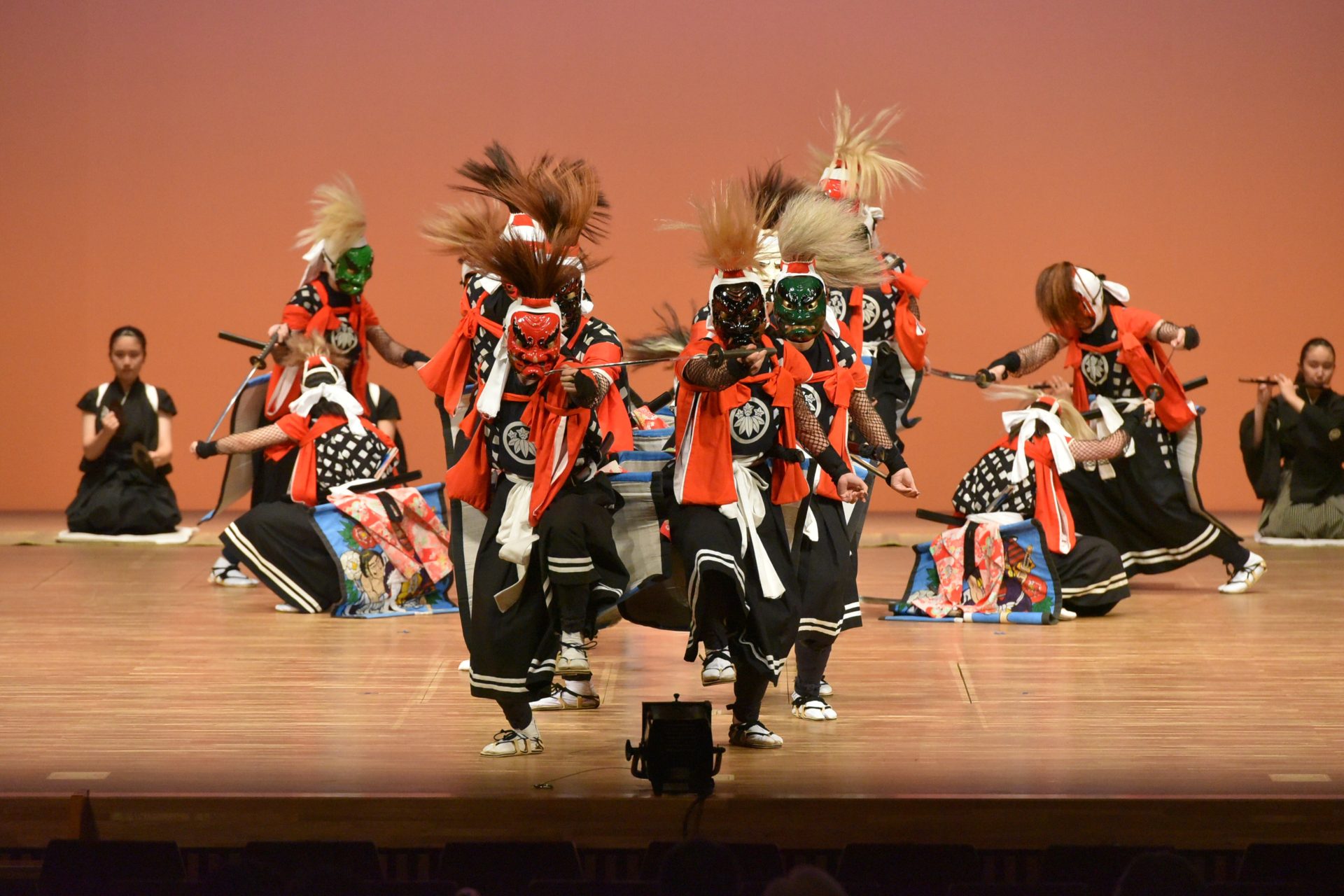
■Ticket information■
■The Geinoh Meeting■
Open Meeting
Discussing the future of Sanriku and geinoh with young practitioners
Young folk performing arts practitioners from Hirono Town and beyond, as well as professional artists and community development coordinators, will gather in Hirono Town to discuss the appeal of the geinoh.
Anyone is welcome to join the meeting, take part in discussing Sanriku and geinoh, or watch and experience the geinoh of the participating groups.
This is an exchange meeting where we can share the creativity and potential that exists in the Sanriku region in various forms, and find new friends.
Please join us in creating the future of this region together in the town of Hirono, where new skills, power, wisdom, and people are gathered. We look forward to your participation!
■Registration■
■map■
■access■
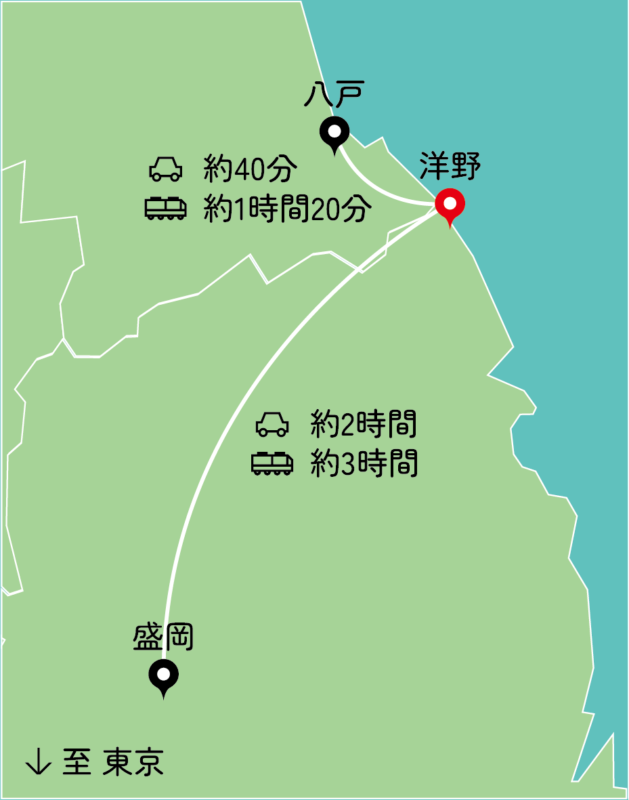
By car:
From Morioka: Take the Hachinohe-Kuji Expressway and exit at Hirono-Uge IC, and drive 15minutes.
From Hachinohe: Take the Hachinohe-Kuji Expressway and exit at Hirono-Taneichi IC, and drive 3minutes.
*Hirono-Uge IC and Hirono-Taneichi IC are half-interchange.
*Sanriku Coastal Highway (Hachinohe Kuji Expressway) is available free of charge, except between Sendai Kohoku IC and Naruse Oku-Matsushima IC.
By train and shinkansen:
From Tokyo:
Take the JR Tohoku shinkansen from Tokyo to Hachinohe (about 3 hours).
Take the JR Hachinohe Line from Hachinohe to Taneichi (about 60minutes).
About a 12 minute walk from Taneichi station.
■Attention■
If you wish to reserve a wheelchair seat, please let us know at the time of registration.
- Due to measures to prevent the spread of COVID-19, admission may be restricted after the performance begins.
- This performance will be conducted in accordance with thorough measures to prevent the spread of COVID-19. We would like to ask for the understanding and cooperation of our audience members in wearing masks, disinfecting hands, and taking temperatures.
- The contents of the event may be subject to change depending on the situation of COVID-19.
- Personal information will be used solely for the purpose of operating and managing this project.
Dancing Through Hirono: The Sanriku Future Geinoh Festival,The Geinoh Meeting Leaflet
PDF:Dancing Through Hirono: The Sanriku Future Geinoh Festival,The Geinoh Meeting Leaflet
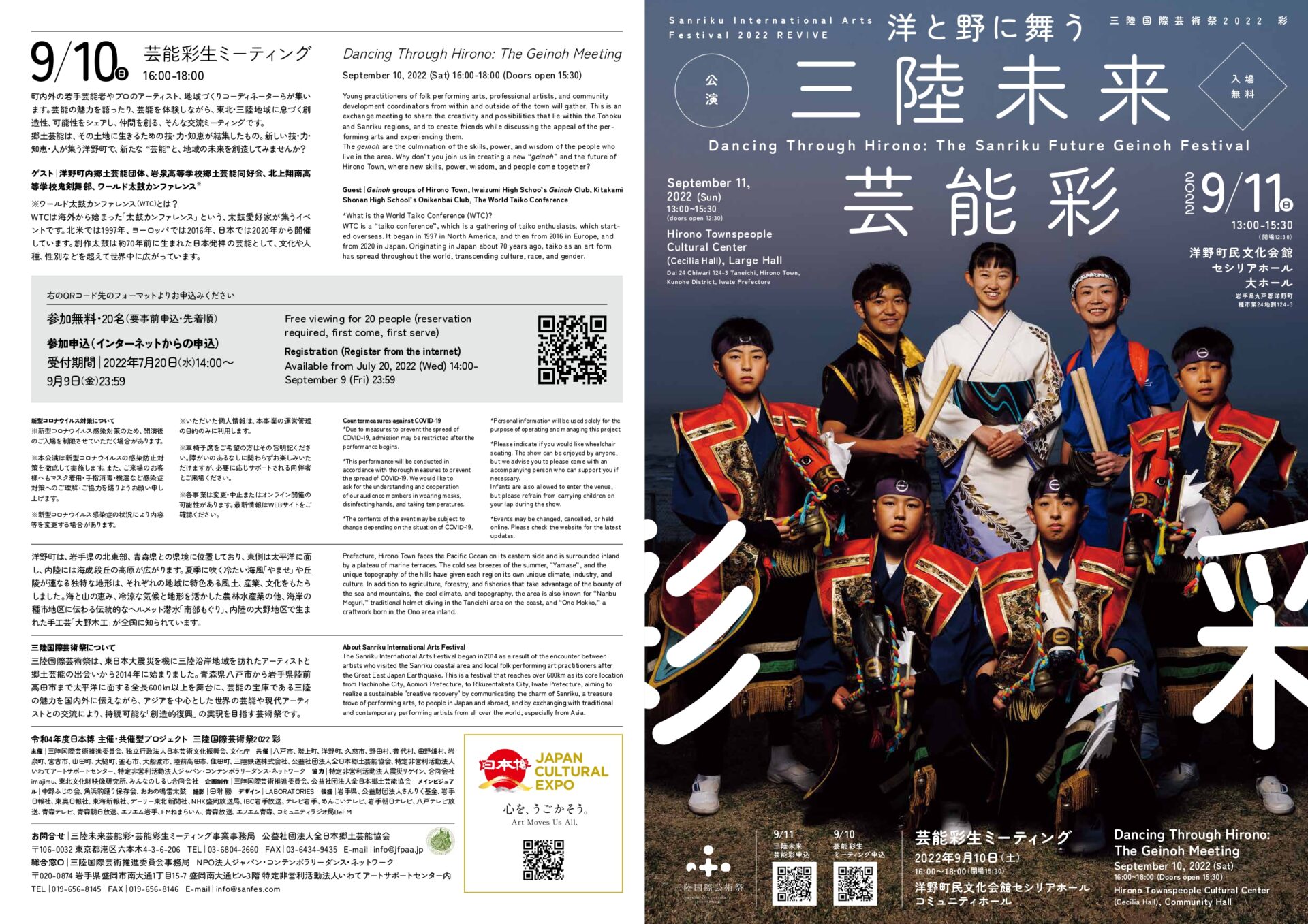
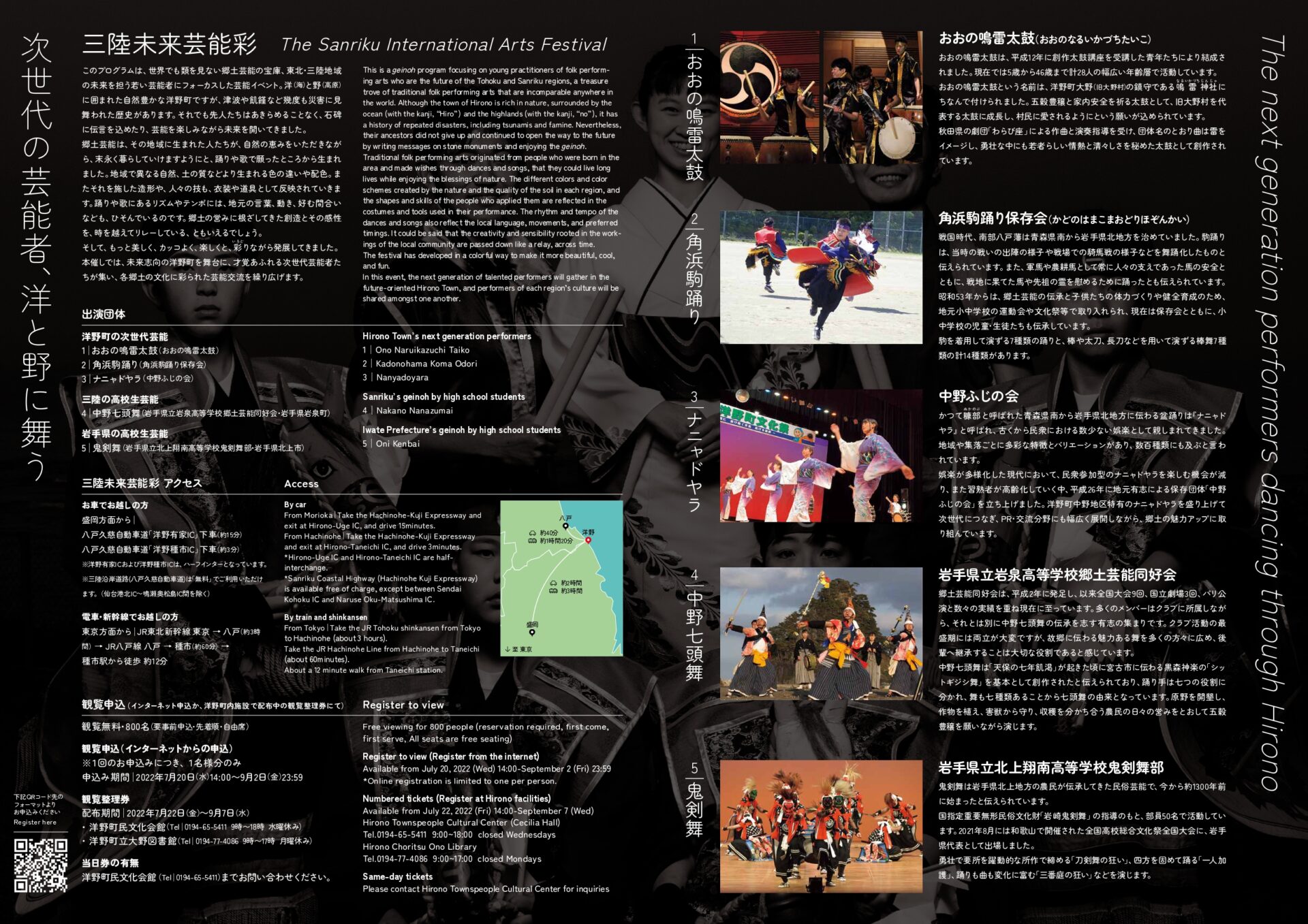
■Contact
Japan Folk Performing Arts Association
4-3-6-206 Roppongi, Minato Ward, Tokyo 106-0032
Phone|+81 (0)3-6434-9434 FAX |+81 (0)3-6434-9435
E-mail | koiwa@jfpaa.jp
Areas
Artists
-
Nakano Fuji no Kai
Bon odori dances from the area once called Nukanobu, spread from the southern Aomori to northern Iwate region, are called “Nanya doyara” and have long been enjoyed as one of the few forms of entertainment among the people. It is said that there are hundreds of varieties of bon odori, with each region and village having their own unique characteristics and variations.
In today’s world of diversifying entertainment, opportunities to enjoy the Nanya doyara with the participation of the people are decreasing, and the number of skilled performers are aging. Nakano Fuji no Kai, a preservation society founded by local volunteers in 2014, is working to enhance the appeal of its hometown by promoting the Nanya doyara, which is unique to the Nakano area of Hirono Town, to the next generation, and by expanding its activities into a wide range of PR and exchange fields. -
Kadono Hama Komaodori Preservation Society
During the Warring States period, the Nanbu Hachinohe Clan ruled the area from southern Aomori to northern Iwate. The Koma Odori dance is said to be a dance that depicts the scene of going into battle, and cavalry battles at that time. It is also said that the dance was performed to comfort the spirits of horses and ancestors who died in battle, as well as to ensure the safety of the horses, which always supported the people as war and farm horses.
Since 1978, the dance has also been performed by children at local elementary and junior high school athletic meets and cultural festivals to pass on the geinoh and to promote their physical fitness and growth.
There are 14 types of dances: 7 dances performed with horse-like costumes, and 7 stick dances performed with poles, swords, and long swords. -
Ono Naru Ikazuchi Taiko
Ono Naru Ikazuchi Taiko was formed in 2000 by a group of young men and women who took a taiko drumming course. Today, the group has 28 members ranging in age from 5 to 46 years old.
The name, “Ono Naru Ikazuchi Daiko”, comes from Naru Ikazuchi Shrine, the town deity of Ono, in Hirono Town (formerly Ono Village). It is hoped that the taiko drumming will develop to become something that represents the former Ono Village, and be loved by the villagers as a prayer for a good harvest and family safety.
Trained in musical composition and performance by Warabi-za, a renowned troupe based in Akita Prefecture, the group is named after the image of lightning, and their drum music is valiant and charged with youthful passion and freshness. -
Iwate Prefecture Iwaizumi High School’s Geinoh Club
Since its establishment in 1990, the club has performed at nine national competitions, three times at the National Theatre of Japan, and once in Paris. Many of the members not only belong to the club, but they are also a group of volunteers who aspire to pass on the Nakano Nanazumai dance. Although it is difficult to balance their activities during the peak season, they feel the need in spreading the local folk dance to as many people as possible, and to pass it on to younger generations.
It is said that the Nakano Nanazumai was created around the time of the “Seven Years of Famine” in the Tempo era based on the “Shittogi-jishi-mai” of the Kuromori Kagura from Miyako City. With the dancers divided into seven roles, and seven different dances comprise the whole, it is said that this is where Nanazumai (literally, seven dances) got its name. The dancers play the role of farmers who cultivate the fields, plant crops, protect them from vermin, and share the harvest, all in the hope of a bountiful gathering. -
Iwate Prefecture Kitakami Shonan High School’s Onikenbai Club
Onikenbai is a geinoh handed down by farmers in the Kitakami region of Iwate Prefecture, and is said to have begun approximately 1,300 years ago.
Under the guidance of Iwasaki Onikenbai, a Nationally-Designated Important Intangible Folk Cultural Property, the club of 50 members participated in the National High School Culture Festival held in Tokyo in August 2021, representing Iwate Prefecture.
They perform a brave and dynamic sword dance called “Katana Kenbai no Kurui”, a four-sided formation dance called “Hitori Kago”, and “Sanban-niwa no Kurui” which is rich in variety in both dance and music, among others.
Sanriku International Arts Festival 2022 REVIVE
– An FY 2022 Japan Cultural Expo Project Presented and Co-presented by Japan Arts Council and Agency for Cultural Affairs, Government of Japan

Organized by|Sanriku International Arts Committee, Japan Arts Council, and Agency for Cultural Affairs, Government of Japan
Co-organized by|Hachinohe City, Hashikami Town, Hirono Town, Kuji City, Noda Village, Fudai Village, Tanohata Village, Iwaizumi Town, Miyako City, Yamada Town, Otsuchi Town, Kamaishi City, Ofunato City, Rikuzentakata City, Sumita Town, Sanriku Railway Co., Ltd., Japan Folk Performing Arts Association, NPO Iwate Arts Support Center, and NPO Japan Contemporary Dance Network
Cooperated by|NPO Shinsai Regain, imajimu LLC, Tohoku Cultural Property Video Research Institute, Minna no Shirushi LLC